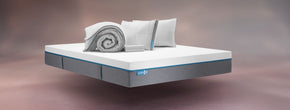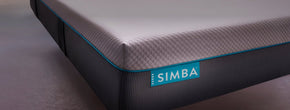How to care for your mattress

You can’t just pop your mattress in the washing machine along with the rest of the bedding, so how should you take care of and clean your mattress?
How to take care of a new mattress
Use a mattress protector
If you don’t already have one, we strongly recommend buying a mattress protector at the same time as buying your mattress, so that you can cover it before you start using it.
This can help if you are sensitive to the new smell that will dissipate within a few days, and also because accidents can happen, even on the first night.
Simba’s breathable Performance Mattress Protector is made with super soft 200 threat count cotton which uses Bi-Ome® technology to actively prevent odours and eliminate microorganisms. Mattress protectors prevent any damage to the top of the mattress, while sealing in any allergens like dust mites.
Pets, periods, hot drinks and all manner of fluids may come into contact with your mattress - so give yourself a head start at keeping it fresh and new with a washable top layer. Our top of the range Hybrid® Luxe mattress has the benefit of a removable top cover for easy washing.
Air and ventilation
Airing your mattress outside in full sunlight on a warm, sunny day is worth doing periodically as sunlight kills bacteria, can help bleach out any staining, and neutralise any nasty odours. Too awkward to move it on your own? By opening all the bedroom windows and moving the mattress into direct sunlight, it will still get the benefit.
Be careful with crumbs
Breakfast in bed is always indulgent but eating in bed is a risky activity, along with consuming hot tea and coffee that are liable to stain if spilled.
How to clean your mattress?
Every six months or so, give your mattress a thorough deep clean.
- Strip the mattress down so that all bedding is removed, plus any protective layers or covers
- Open all the windows in the bedroom to air the mattress
- Vacuum the top of the mattress, paying attention to any crevices, corners, or piping where dust may have collected
- Spot clean any marks or stains using a homemade solution of washing up liquid and warm water and just apply the foam to lift the stains
- Don’t soak the mattress, if it gets to wet it can encourage bacteria or mould to grow, instead use a damp cloth or an old toothbrush to gently scrub the surface
- Alternatively, you can clean your mattress with bicarbonate of soda (from the cleaning aisle not baking section), use a sprinkle, mist lightly with water, allow to dry, dust off and vacuum thoroughly
- You can also use a steam cleaner to spring clean your mattress
How often should you clean your mattress?
Every six months is fine, however, to prevent stains, treat any spills or accidents as soon as possible. If you’ve knocked a drink over, cover the wet patch with a bath towel and place a heavy object on top, such as a door stop or a stack of books, to help draw the liquid out of the mattress.
Salt is also very effective at removing blood stains - apply a thin layer directly over the stain with a drop of water, allow to dry and vacuum off.
Why should you clean your mattress?
We spend a third of our lives asleep, and so a mattress should be cleaned regularly to help minimise the build up of dust and allergens and to keep it from developing any odours.
How often should you rotate a mattress?
It depends on the type of mattress, and manufacturers recommendations often vary, but flipping your mattress roughly every three to six months will help prevent wear and tear.
Thankfully, you don't have to turn Simba mattresses, but rotating your mattress regularly is one of the very few conditions of our ten-year warranty. Take it for a 180-degree spin on the base once a month for the first three months, then every 3-6 months for the rest of its life.
To make life easier for you, the Simba Hybrid®, Pro, Luxe & Simbatex® Foam mattresses come with handles for a simpler spin (excludes single and small double sizes). All sizes of the GO Hybrid® mattress have handles.
When should you replace your mattress?
Simba mattresses are guaranteed for ten years. The average mattress needs replacing every 8-10 years, or as soon as it develops any dipping, sagging, lumps, or bumps.
"I can't believe the difference that it has made to my life."-Aaron L, Hybrid® Pro Mattress
"It’s been a game changer. It’s like lying on a cloud"- Miss P, Hybrid® Luxe Mattress














